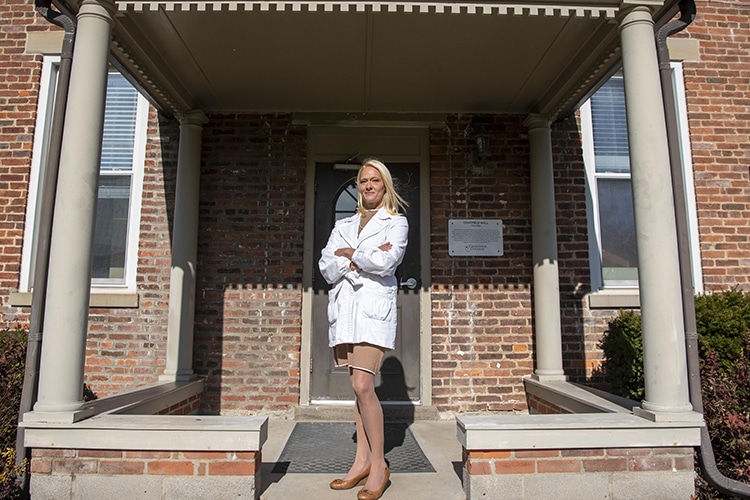Recognizing nonprofits’ impact
Three umbrella organizations that support regional nonprofits wanted to document their economic impact – and, more to the point, emphasize that such organizations are community contributors rather than a resource drain.
Unfortunately, the perception of employees at nonprofit organizations is akin to volunteers. And, while beneficence is certainly a common characteristic for those who work for 501(c)(3) entities, it’s unfair to these individuals and their organizations’ difficult, necessary work to equate their efforts to well-meaning, but trivial, diversions that minimally impact the “real” world.
Three umbrella organizations that support Greater Cincinnati nonprofits wanted to document their economic impact – and, more to the point, emphasize that such organizations are community contributors rather than a resource drain that many less-than-charitable individuals wrongly characterize them to be.
As the cost of living continues to lurch upward without corresponding wage increases, making charitable donations presents challenges for many. The difficulty in having asks for support land is amplified by the raw tonnage of media messages and compassion fatigue seeping into society, creating harsh actions such as the homeless bans in Grants Pass, Ore., that the Supreme Court recently upheld.
Against this backdrop, the onus has been placed on nonprofits to justify themselves as economically vibrant and a societal contributor. With this in mind, the Human Services Chamber of Hamilton County, the Leadership Council for Nonprofits, and OneSource Center for Nonprofit Excellence commissioned the University of Cincinnati’s Economics Center to create an Impact Report that measures economic contributions that Greater Cincinnati’s 300-plus nonprofits provide for our region’s local economy.
The results provide a compelling case for the impact that area nonprofits have on Greater Cincinnati’s economy. Three nonprofit-sector leaders provide insights on what they gleaned from the report, and how they hope it will strengthen these organizations.
How it was done
First, the goal of an economic impact survey is to measure the direct and indirect economic effects produced by an organization or industry. Direct impact measures expenditures, jobs, and wages directly generated by the measured organization(s), whereas indirect impact gauges subsequent spending through revenue, jobs, and wages within other, interconnected business or industries.
In conducting the six-month-long study, the Economic Center primarily obtained information from organizations’ Forms 990 to pinpoint their expenditures for purchases and wages. When this form’s data was unavailable, researchers accessed unemployment-insurance information from the Ohio Department of Job and Family Services. The Economics Center also sent a survey to nonprofits from the combined membership of the three groups seeking their number of paid workers and outlays on purchases and wages.
State and local earnings-tax revenues were measured to verify wages organizations directly and indirectly supported. To measure sales tax generated, the Economics Center implemented the Bureau of Labor Statistics Consumer Expenditure Survey for the Midwest region to determine the amount of wages applied to taxable purchases.
The impact report broke down organizations into five classifications based on the NAICS code provided on their Forms 990:
- Professional, Scientific, and Technical Organizations (10 total, example: Legal Aid Society of Greater Cincinnati)
- Educational Services (24 total, example: Learning Grove)
- Healthcare and Social Assistance (157 total, example: Freestore Foodbank)
- Arts, Entertainment, and Recreation (20 total, example: Cincinnati Museum Center
- Other Services (undefined community assistance) (91 total, example: St. Vincent DePaul
- Other (10 total, undefined)
Key data points
Broken down by county, of the combined membership of the three groups surveyed, 250 charities are headquartered in Hamilton County, generated $2.5 billion in direct and indirect output, roughly 33,700 direct and indirect jobs, and $1.15 billion indirect and indirect wages. The nonprofits headquarters in the remaining counties (Kenton and Campbell in Kentucky, Butler, Clermont, and Warren in Ohio, and “Other,” which presumably includes Boone County in Kentucky and Dearborn County in Indiana, among others) total roughly $310 million in direct and indirect economic output, more than 7,300 direct and indirect jobs, and $182.1 million in direct and indirect wages.
Expert insights
Mike Moroski, a former English teacher and Cincinnati Public Schools Board member, is a nonprofit veteran whose has operated or served on the boards of nonprofits for 25 years. He currently serves as the executive director of the Human Services Chamber of Hamilton County, which supports approximately 90 of the county’s human services nonprofits.
He provided the initial impetus for the report, noting that “the impact of the nonprofit sector hadn’t previously been measured in economic terms.” And, as the economic model has evolved, it’s especially timely to measure it.

“In my parent’s generation, every organization used communication through mail and mass media to obtain donations,” he said. “Now, there are many more narrowly focused organizations. I don’t know if it’s just millennials and Gen Z driving this, but there is more interest in supporting organizations focused on specific issues.”
Also, he noted given COVID-19’s ongoing fallout, interest and participation in in-person events has waned, which has forced organizational attrition and adaptation. Crowdsourcing has become a popular fundraising tool but impacts larger organizations less. Also, as workplaces become increasingly remote, donation programs through employers have been deemphasized.
Amid this challenging backdrop, it became vital to affirm nonprofit’s collective strength to support their multifaceted service to those in need. Moreover, Moroski noted that the role nonprofits fulfill is so ingrained that it can be taken for granted – amplifying the need for the impact report.
“It’s been hundreds of years since governments realized they couldn’t fulfill all of their citizens’ needs, and nonprofits were born,” he said. “Nonprofits have an opportunity improve their operations, but there are so many needs. Addressing them requires collaboration on several levels: between organizations, with government officials, with engaged citizens, to make it happen. The report provides a compelling argument for that.”
He continued, “The goal was a document that shows the impact. People broadly respect the work nonprofits do, regardless of their politics. But I don’t believe we’re taken as seriously as for-profit business.”
Moroski noted, during the development of the Futures Commission Report only two of the 50-plus Commission participants were nonprofit professionals, which underscored the need for documentation for nonprofits’ contribution. The Futures Commission Report recommended raising the city’s earnings tax from 1.8 to 1.95%, with a portion of the revenue increase – Moroski quoted a figure of $50 million — allocated to nonprofits to provide affordable housing and other essential services.
“It would be powerful for the Cincinnati Regional Business Chamber and Human Services Chamber, OneSource, Leadership Council for Nonprofits, and other influential organizations to be aligned on pushing for an earnings tax increase,” Moroski said. “A report that plainly states the impact of the nonprofit sector strengthens our position.”
He continued, “Nobody on Fourth Street is going to come to me for investment advice. By that same token, they’re not experts on meeting the needs of our most vulnerable citizens. We have diverse types of expertise, they’re all relevant, and by recognizing each sector’s impact and working together, we can achieve common goals. This report emphasizes the importance of our work. I understand that we’re not going to be the first call for major economic development projects. But we should be the second or third call.”
He enlisted Christie Brown, CEO of OneSource Center, and Beth Benson, executive director of Leadership Council for Nonprofits, to muster their organizations’ strength.
(Find the final report for review and download here.)
OneSource Center provides goods and materials to nonprofits through its Common Goods retail store, leadership development programs, and consulting services to improve organizational effectiveness. Brown, who has worked for the organization for nine years, said the nonprofit landscape has changed through an increased use of social enterprises, such as retail or production facilities that employ members of the population a nonprofit serves to diversify beyond government or donor funding for revenue streams.

During her tenure, Brown has observed steady growth of nonprofits even amid the attrition and consolidation of organizations. This is partly attributed to a broader array of organizations meeting increasingly complex needs, but she noted that revised rules that allow organizations with less than $50,000 in annual revenue to gain tax-exempt status makes it very (sometimes too) simple to start a nonprofit.
She’s grateful that tangible data has been created to measure the contributions nonprofits make to Greater Cincinnati: “People acknowledge the work we do, but don’t think about what we add to the community economically. Additionally, many organizations with job-training programs help hard-to-employ people find work. Helping citizens become contributing, tax-paying citizens provides significant, long-term impact.”
Brown noted that the report reinforces the National Council of Nonprofits’ data that nonprofits employ more than 10% of the U.S. workforce, which surpasses the number of jobs provided by the manufacturing, construction, and finance industries.
She said that sheer size of roughly $3 billion of economic impact was a positive surprise: “Intuitively, we knew that we were a significant economic factor to the local economy, but it was a bigger number than I expected.”
One of the report’s tables reflected the perception that nonprofits don’t pay as well as comparable roles at for-profit businesses. It noted that, in aggregate, the nonprofits surveyed represent 1.6% of all jobs in the Cincinnati MSA but pay only 0.9% of wages. The discrepancy is most pronounced in the Health Care and Social Assistance sector, where they comprise an 8.4% share of jobs, but only pay 4% of wages. Brown noted that there had been improvement, but that more could be done to make nonprofits more competitive as a career path.
“Coming out of COVID-19, workers came back expecting to be paid a living wage, so we had to increase salaries to be more competitive,” she said. “As a resource center, we’re working on negotiating how we can help our organizations be able to affordably offer better benefit and retirement packages to help attract quality workers.”
Dividing the number of direct nonprofit jobs (24,003) by the number of nonprofit (312) translates to an average of 76 employees per organization. Brown emphasized that median and the mean are far apart on this data point.
“Sixty percent of the nonprofits our organization serves have annual revenue of less than $1 million,” she said. “Children’s Hospital is technically a nonprofit, so the thousands of employees of organizations like that will skew the average.”
Even given nonprofits’ divergent circumstances, they face the common pressure to justify their costs and articulate how they provide a return on investment. Brown said, “Individually, nonprofits can use this report’s data to improve their grant requests and boost enthusiasm with supporters. This report is an important step.”
In the future, Brown thinks the metrics will change as needs evolve and the nonprofit realm responds to them: “In the future, I think more collaboration between nonprofits will be important. Housing and food insecurity are growing problems, climate change is a concern, and nonprofits will continue to evolve to meet those needs. These needs are complex, and it’s better for organizations to not work in silos. As they optimize their work, nonprofits’ impact and economic contributions will continue to grow.”
In the future, Brown hopes that a report that measures the value and impact of work nonprofits perform to complement this report’s economic impact measurement but acknowledges that would be a more arduous undertaking.
Leadership Council’s Benson refers to herself as a “nonprofit lifer.” She has worked in the industry for more than 30 years, beginning her career with Keep Cincinnati Beautiful, then moving on to SORTA, Greater Cincinnati Foundation and later to Habitat for Humanity before taking on her role at the Leadership Council for Nonprofits. Leadership Council serves about 250 nonprofits by offering leadership development, training, and networking opportunities for its members.

“We’re fortunate in this community to have a large philanthropic community, and have many engaged volunteers, supportive policymakers and impactful foundations,” she said. “But many aren’t aware of the contributions nonprofits makes as employers, consumers, and the survey reflects that.”
She continued, “Nonprofits are more than charity. In addition to the impact on quality of life produced by the organizations in the study, we return as much to the region’s economy as comparably sized sectors. The nonprofit industry makes a much larger impact than most people would expect through employment, buying power, and tax revenue.”
She noted that any economic challenges that are discussed for the for-profit sector are equal, if not amplified, in the nonprofit world: “If you don’t have enough caseworkers or substance-abuse counselors to help people end their addiction, it negatively impacts not only the person, but the community and the economy, on several levels.”
Benson went on to add that nonprofit workforce development will be a future focus of Leadership Council’s programming to help publicize the career pathways available in the sector and attract workers at all stages of their careers. “Whatever you wanted to be when you grew up, we need you in the nonprofit workforce. We need nurses, teachers, truck drivers, accountants, cashiers – you name it.” Her hope is that the economic data helps draw attention to the sector as a career of choice. “We are a force for good,” she said.
The publication of The Economic and Fiscal Impact of the Member Organizations of the Human Services Chamber of Hamilton County, the Leadership Council for Nonprofits, and OneSource on the Cincinnati MSA in Soapbox has been made possible with support from the Leadership Council for Nonprofits.














